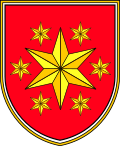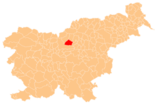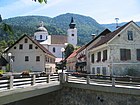Gornji Grad (Slovenia)
| Gornji degree | |||
|
|||
| Basic data | |||
|---|---|---|---|
| Country |
|
||
| Historic region | Lower Styria / Štajerska | ||
| Statistical region | Savinjska (Sann area) | ||
| Coordinates | 46 ° 18 ' N , 14 ° 48' E | ||
| surface | 90.1 km² | ||
| Residents | 2,595 (2002) | ||
| Population density | 29 inhabitants per km² | ||
| Post Code | 3342 | ||
| License Plate | CE | ||
| Structure and administration | |||
| Mayor : | Anton Špeh | ||
| Website | |||
Gornji Grad (German Oberburg , Obernburg ) is a place in Lower Styria (Spodnja Štajerska) in Slovenia . The landmark of Gornji Grad is the Cathedral of Saints Hermagoras and Fortunatus , which is related to the Benedictine monastery of the same name, which was built there and dissolved around 1471.
Geographical location
With its 950 inhabitants, the center of Gornji Grad and six other villages form the municipality of the same name with an area of approx. 90 km² and around 2700 inhabitants.
The place, which is traversed by the larger mountain stream Dreta (Drieth), is on the main road that connects the Laibacher Kessel via Kamnik (German stone) in Upper Carniola with the Sanntal (Savinjska dolina) in Lower Styria. The distance to Celje (Cilli) is about 36 km, and that to Ljubljana (Laibach) about 55 km. The settlement is surrounded by high, densely forested mountains. In the north the mountain ranges Ajčjak 911 m , Kicelj 910 m and Rogatec 1557 m and in the south the mountains of the karst plateau of the Menina Planina with heights of 1200 to 1500 m. A valley basin opens to the east, from which two roads lead into the Sanntal. In a westerly direction, the road meanders along the Driethbach to the Črnivec sedlo mountain pass (902 m). The state border between Styria and Carniola once ran here at the top of the pass (since 1311; before this part of the Sann area belonged to Carinthia).
Districts of the entire municipality
- Bočna , (German: Sankt Peter am Drieth )
- Dol , (German: Thal near Oberburg )
- Florjan pri Gornjem Gradu , (German: Sankt Florian bei Oberburg )
- Gornji Grad , (German: Upper Castle )
- Lenart pri Gornjem Gradu , (German: Sankt Leonard bei Oberburg )
- Šmiklavž , (German: Sankt Nikola bei Oberburg )
- Tirosek (German: animal stone )
coat of arms
Description : In red a six-pointed, faceted golden star accompanied in the angles by six smaller stars of the same kind.
history
The area - the upper Sanntal (Savinjska dolina) - in which Gornji Grad is located, belonged to the high free thief von Chager ( von Kager ) and his wife Truta at the beginning of the 12th century . At that time, the castle and rule of Oberburg already existed, and Schmutz names the Counts of Heunburg and the von Oberburg as their owners in addition to the Chagern . Later Oberburg came to the Counts of Cilli . After the Cillier went out, Oberburg became sovereign. In a document of the Patriarchate of Aquileja from 1243 the "old" castle Oberburg ( antiquum castrum ) is mentioned. The castle was built on a steep hill called Gradišče , where the remains of the wall could still be seen around 1820. The von Altenburg knight dynasty appears as the owner of the Oberburg Castle Office in the 14th century .
Foundation of the Oberburg monastery
In 1140 Diebald von Chager handed over this area including the fortress Oberburg to the Patriarch of Aquileja Peregrin and founded the Benedictine monastery "Obremburch" with him. The deed of foundation dates from April 7th, 1140 (Božo Otorepec). At that time the monastery got 500 subjects and their families, forests with clearing rights as well as hunting and fishing rights. Other donors followed, who increased the property of the monastery; to name a few: 1209 Margrave Heinrich of Istria, 1216 Bernhard von Flödnigg (Smlednik in Upper Carniola). On 18 December 1241, Count Wilhelm resigned from Heunburg the monastery the Bailiwick law from some churches and bailiwicks. This was followed by Hartneid von Pettau in 1243 , Hermann von Plumenstein in 1247, Kunz der Rothe in 1248, Otto von Kumberg and Duke Ulrich III in 1257 . von Carinthia, 1269 Uleman von Görtschach, 1273 Hartneid von Gutenstein, 1274 King Ottokar II. Przemysl of Bohemia, 1275 Ulrich von Habsbach and Otto von Thurn , 1278 Leopold von Sanneck , 1279 Günther von Heggenberg, 1282 Hermann von Oberburg , 1286 Otto von Drachenberg , 1297 Otto von Montpreis , 1298 Otto and Heinrich von Rechberg , 1312 Niklas von Oberburg , 1322 Konrad von Altenburg, 1326 Count Ulrich V. von Pfannberg , 1369 Hermann Graf von Cilli . In 1447, Count Friedrich von Cilli granted the monastery the right to try criminals with the exception of the death penalty. In the course of the construction work for the monastery, the cathedral of Saints Hermagoras and Fortunatus, which still exists today, was built, which has been rebuilt several times over the years; it and its dome are the largest in Slovenia in terms of area.
A women's monastery was also attached to the monastery for a while.
Abbots of the monastery (after dirt)
The list is incomplete. And based on the first names alone, no conclusions can be drawn about the origin of the abbots.
- Berthold 1145
- Elizabeth 1175
- Albert 1228-1231
- Heinrich 1243-1265
- Johann 1268-1286
- Otto 1291
- Wulfing 1296 - 1308 was held in captivity by Count Friedrich von Heunburg for a long time
- Leopold 1309
- Niklas 1311
- Johann 1347
- Ulrich 1355-1365
- Niklas 1365-1404
- Wulfing 1408
- Georg 1410, Pope Johannes (XXIII., 1410 - 1415, antipope) placed the monastery under the protection of the Gurk diocese .
- Niklas 1411
- Konrad 1427
- Rudolf 1438-1443
- Ulrich 1444
- Caspar 1453-1460
- Gregor, the last abbot of Oberburg. On October 11, 1463, he handed over all the documents in the German House in Laibach.
Bailiff
The Vogtei over Oberburg owned:
- 1140 probably Diebald von Chager, co-founder
- until around 1250 the Free of Sanneck
- until 1286 the lords of Pettau
- 1286–1322 the Counts of Heunburg
- 1322–1337 Count Ulrich V. von Pfannberg
- 1337–1352 Friedrich the Free von Sanneck, since 1341 Count von Cilli
- 1352–1361 the pen itself
- 1361–1372 the dukes of Austria
- from 1372 to the extinction of their male line in 1456 the Counts of Cilli
Dissolution of the monastery
As early as 1237, Patriarch Berthold von Meranien toyed with the idea of founding a new diocese instead of Obernburg or transferring the dilapidated diocese of Piben here. Pope Gregory IX had this examined benevolently.
Emperor Friedrich III. who initially confirmed all privileges , rights and property to the monastery , after the death of Abbot Gregor forbade all further abbot elections because he founded the Diocese of Laibach and wanted to incorporate Oberburg into it. The emperor issued the founding document for the Diocese of Ljubljana in 1461 in Graz . However, the monks opposed these measures and elected the one-eyed monk Gregor Hinig from Treffen ( Trebnje in Lower Carniola) as the new abbot. By order of the Pope, this election was declared null and void by Ulrich, the Bishop of Gurk , and violations were made a punishable offense. Gregor Hinig did not give up, however, and defied the first bishop of Ljubljana , Sigismund von Lamberg (1461–1488), a contract according to which the monastery was to be paid 120 ducats for the delivery of the documents and for the assignment of rights and privileges.
Due to the moral decline in the monastery, but also because of the emigration of the population in view of the Turkish threat - Oberburg was devastated by the Turks in 1471 - the monastery was dissolved by the Pope in 1473 on the initiative of Bishop Lamberg. A college for secular priests was then created .
The bishops of Laibach temporarily used Oberburg as a residence . In 1518, Bishop Christoph von Rauber (1497–1536) had the monastery building, which had not been secured until then, fortified with a wall, five towers and a moat.
particularities
- In the entrance area to the Oberburg Cathedral, you can see the gravestone of the imperial field captain Johann Kazianer , who fell out of favor with the emperor in 1537 due to a failed military mission at Esseg (Croatian Osijek ) and was murdered by Count Nikolaus Zrinyi in 1538 .
- Friedrich Heinrich von der Hagen expressed the assumption that the minstrel " von Obernburg " came from Oberburg and was a clerk of the local monastery .
- In the presbytery of the cathedral there commemorates Sigismund von Lamberg, the first bishop of Laibach, a memorial plaque and a statue, both of which were later placed there at the instigation of Laibach bishop Thomas Chrön (Hren).
- Gornji Grad - Upper Castle, Cathedral of Saints Hermagoras and Fortunatus
Personalities
- Leonhard Kern (1588–1662), a German sculptor who also worked in Gornji Grad in the early 17th century. The high altar of the local church, made in 1613, comes from him.
- Marx Schokotnigg (1661–1731), Austrian baroque sculptor, baptized in Oberburg
literature
- Carl Schmutz: Historical-topographical lexicon of Steyermark, third part, Graz 1822
- Hans Pirchegger: The Lower Styria in the history of their dominions and Gülten, cities and markets, in: Book series of the Southeast German Historical Commission, Volume 10, Munich 1962
- August Dimitz : History of Krain, Part 2, Laibach 1875
- Hans Pirchegger: History of Styria , Graz 1949, Reprint 1987





